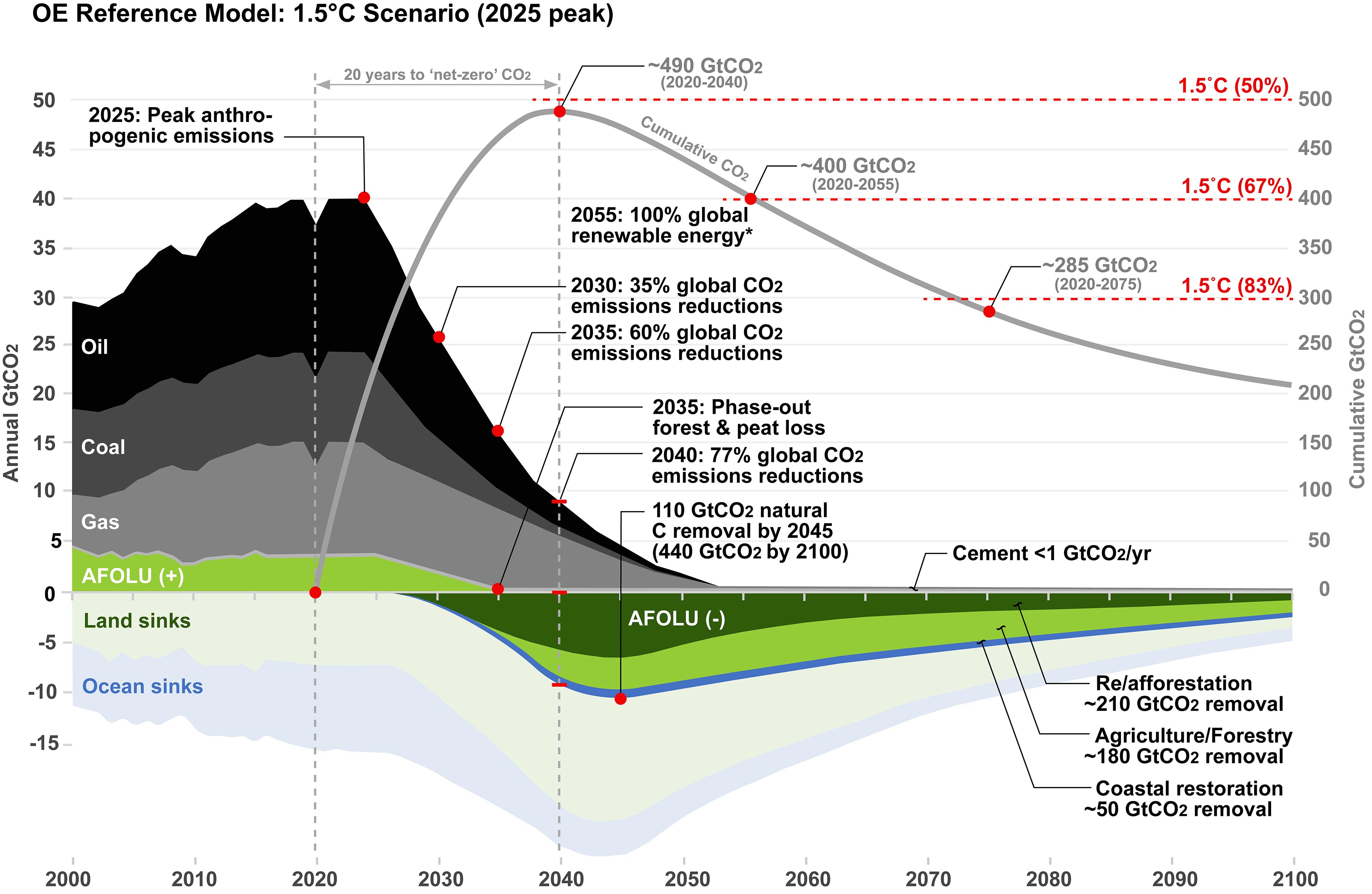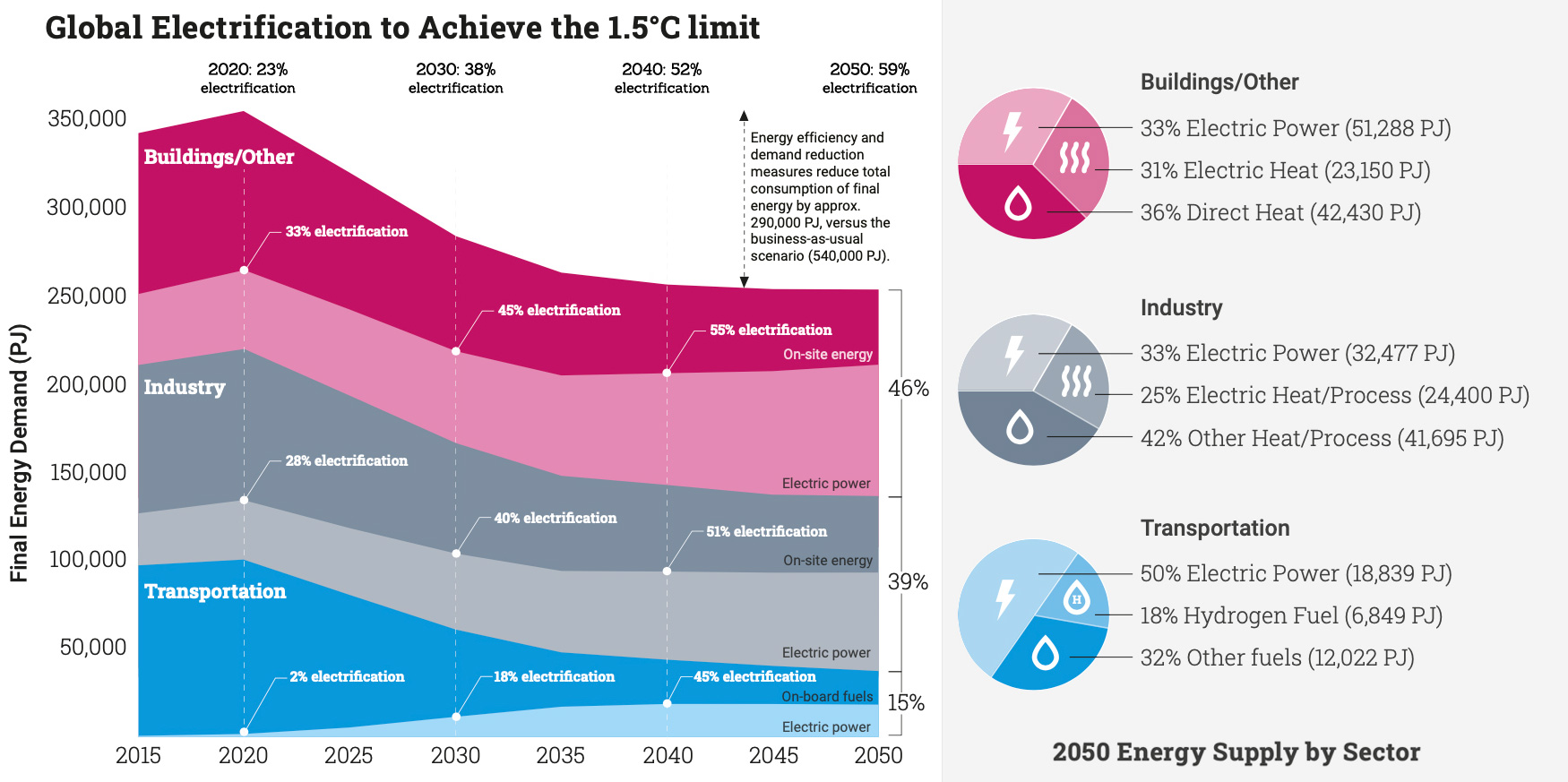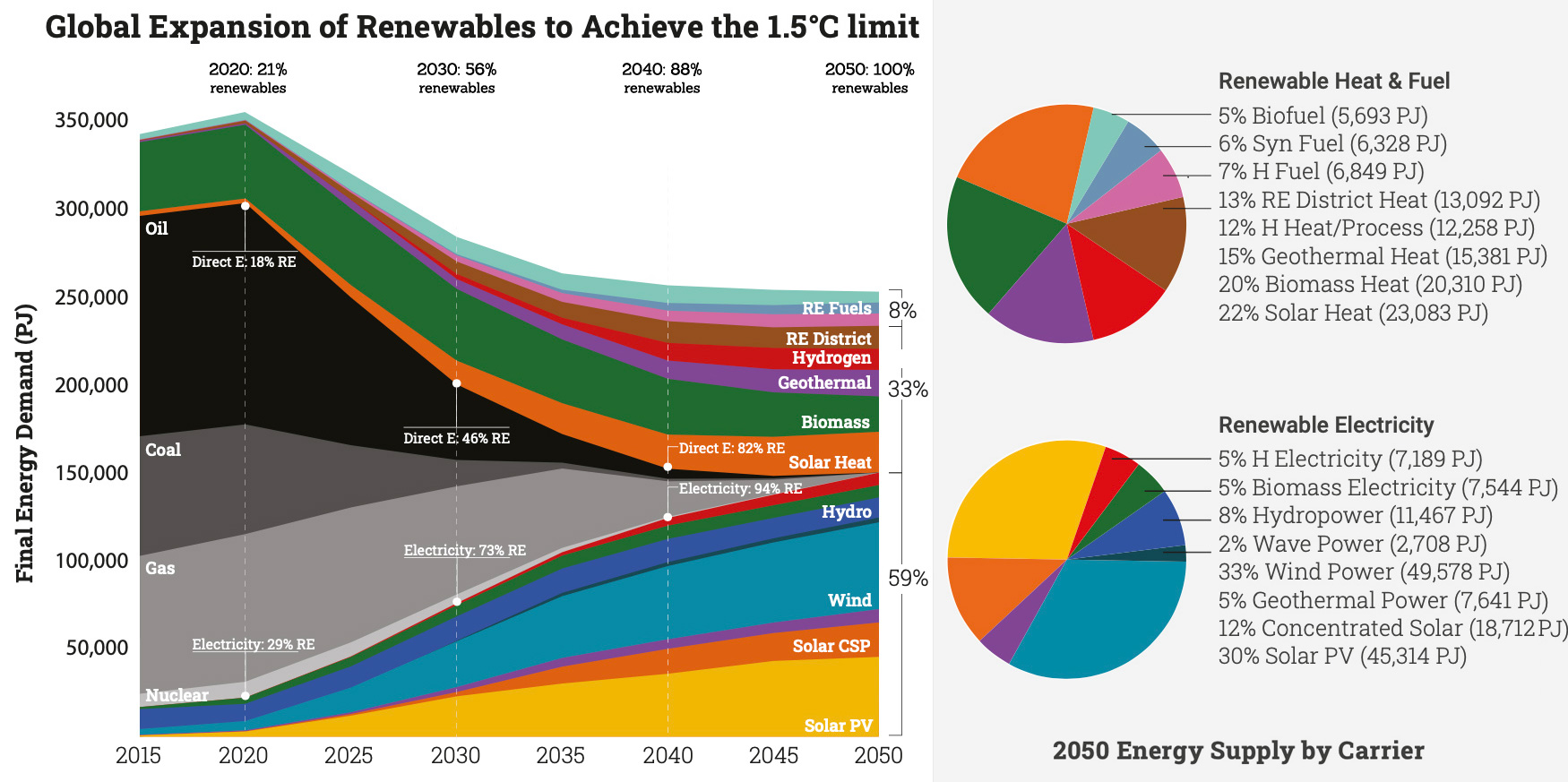.jpeg?auto=compress%2Cformat)
Achieving the Paris Climate Goals in the COVID-19 era
A breakthrough climate model, the product of a two-year collaboration with 17 leading scientists, shows that we still have a window to stay below the dangerous threshold of 1.5 degrees Celsius, achieving net-zero emissions before 2040.
As the world recovers from the COVID-19 pandemic, we must think carefully about the future that we want to build. We face a worsening climate crisis, with record temperatures causing rampant fires, rapidly melting polar ice, and extreme flooding. The world has already reached a global average temperature rise of 1.1 degrees Celsius above pre-industrial levels. A world of 1.5 degrees Celsius is almost unimaginable and must be avoided at all costs.
Fortunately, a breakthrough climate model shows that we have a window to stay below the dangerous threshold of 1.5 degrees Celsius, achieving net-zero emissions before 2040. The two-year collaboration with 17 leading scientists, entitled Achieving the Paris Climate Agreement Goals (APCAG), shows that we can prevent the worst impacts of climate change with currently available solutions, unlocking trillions in economic benefits.
Foundations 20 (F20), in partnership with One Earth and the University of Technology Sydney, developed an Executive Briefing to condense the nearly 500 pages of scientific text into a high-level overview, entitled “Achieving the Paris Agreement Goals in the COVID-19 era.” Designed for professionals in the NGO and philanthropic sector, as well as business and governmental decision makers, the briefing provides a quick summary of the roadmap to achieve the ambitious 1.5°C goal.
In the 1.5C scenario, there are two main efforts required -- a rapid decarbonization of our energy system and large-scale land restoration -- which combined, provide a 66% likelihood of staying below 1.5 degrees Celsius.
For the global energy transition, electricity use will roughly double from today's levels by 2050, meeting a majority of our energy needs across all three major sectors -- Transportation, Industry, and Buildings & Infrastructure. Half of all transportation will be powered by electricity, with hydrogen and other renewable fuels replacing petroleum products. Industry will double its electricity use, meeting more than one-third of heating & process-energy requirements in addition to other renewable fuels. Buildings & infrastructure will also double electricity use, with more than one-third of heating needs met by geothermal, biomass, and solar heat sources.
Coal will rapidly diminish, followed by a gradual phaseout of oil & gas, while renewables will expand from approximately 20% today to 100% in 2050. This is led by a rapid expansion of solar and wind power, which will meet 75% of electricity demand by 2050. Renewable fuels and energy efficiency will play a major role in reducing overall consumption, driven by smart-grid transmission, more efficient appliances, better transportation logistics, and other measures.
The transition to 100% renewable energy for all electricity and heating requires supplemental investments of $1.1 trillion per year, less than one-quarter of what governments currently spend on fossil fuels.

Even with this rapid energy transition, staying below 1.5 degrees Celsius will require a major effort to protect and restore natural ecosystems -- the carbon sinks which keep our global climate system in balance. In addition to a rapid phaseout of carbon emissions from deforestation, the 1.5C scenario identifies a large potential for carbon dioxide removal through four restoration pathways.
Natural forest restoration, combined with reforestation on 350 million hectares of degraded land, alongside sustainable forestry practices, can deliver 480 billion tonnes of carbon dioxide removal by 2100. In the agriculture sector, reducing nitrogen and methane emissions, along with tree planting on croplands, can deliver the additional mitigation required to stay below 1.5 degrees Celsius.
The 1.5C transition model was developed using a sophisticated computer simulation of the world’s electrical grids — with 10 regional and 72 sub-regional energy grids modeled in hourly increments to the year 2050, along with a comprehensive assessment of available renewable resources like wind and solar, minerals required for manufacturing of components, energy efficiency measures, and configurations for meeting projected energy demand and electricity storage for all sectors through 2050.

The One Earth Reference Model, updated in 2022, limits global average temperature to 1.55°C above early industrial levels (c.1850-1900) with a peak in cumulative anthropogenic emissions of approximately 500 GtCO2 in 2045 (above 2020 levels). This is achieved by (1) a rapid reduction in fossil fuel emissions (black) with approximately 50% of projected energy demand met through renewables by 2035 and 100% renewable energy across all sectors by 2055*; (2) a full phaseout of deforestation and peat loss by 2035 with ongoing net-zero emissions from all other land uses (such as agriculture and forestry); and (3) approximately 110 GtCO2 of carbon removal by 2045 and 450 GtCO2 by 2100 from 11 ecosystem restoration pathways (green and blue). The model relies upon a rapid reduction of both methane and nitrous oxide emissions by 2040 -- one-half and one-third respectively. *100RE excludes direct emissions from cement production and some industrial processes, totaling < 1 GtCO2/yr. The greenhouse gas scenario was run with MAGICC7, a prime reduced-complexity model to determine radiative forcing and projected global temperature rise, based on IMAGE quantification of the SSP1-Baseline scenario in the IPCC SR1.5 database. The model projects that natural land carbon sinks (light green) and ocean carbon sinks (light blue) continue to function through 2100, but decline in the second half of the century. The energy decarbonization scenario is optimized for 72 sub-regions modeled in hourly increments with a final emissions peak in 2025. The results are in alignment with the carbon budgets documented in IPCC’s Sixth Assessment Report (WGI, 2022) -- 500 GtCO2 for a fair chance (50%); 400 GtCO2from 2020 for a good chance (67%); and 300 GtCO2for a near certainty (83%) of limiting warming to 1.5°C. Note: The temporary drop in fossil fuel emissions due to the COVID-19 pandemic appears to occur before 2020 in the scenario timeline. This is due to the standard practice of plotting average annual emissions, rather than monthly emissions, and does not affect the final results.
All three sectors are increasingly electrified through 2050. Transportation moves from 2% electrification to 50%. Industry moves from 28% to 58%, with a large amount of heat/process demand met through electrified heat in 2050. Electrification of the Residential/Other sector moves from 33% to 64%, with nearly half of heating demand met by electricity. Note: Total energy demand is decreased through energy efficiency and demand reduction measures.

All three sectors are increasingly electrified through 2050. Transportation moves from 2% electrification to 50%. Industry moves from 28% to 58%, with a large amount of heat/process demand met through electrified heat in 2050. Electrification of the Residential/Other sector moves from 33% to 64%, with nearly half of heating demand met by electricity. Credit: One Earth
Coal, Oil, and Gas are gradually phased out as electricity demand is met increasingly through renewable power generation, while fossil fuel-based liquid fuels are replaced by renewable fuels. Fossil fuels required for building heat and industrial processes are also phased out as renewable solar, geothermal, and other forms of renewable heat are ramped up. In 2050, approximately 59% of total final energy demand is met by renewable electricity.

Coal, Oil, and Gas are gradually phased out as electricity demand is met increasingly through renewable power generation, while fossil fuel-based liquid fuels are replaced by renewable fuels. Fossil fuels required for building heat and industrial processes are also phased out as renewable solar, geothermal, and other forms of renewable heat are ramped up. In 2050, approximately 59% of total final energy demand is met by renewable electricity. Credit: One Earth
View the F20 webinar with presentations by some of the experts involved in the climate model. Click on the images below to explore regional 1.5C energy transition pathways and land restoration potential divided into 10 global regions.

-
OECD North America
Achieving the Paris Climate Goals for OECD North America. This region includes the United States of America, Canada, and Mexico.
-
OECD Europe
Achieving the Paris Climate Goals for OECD Europe. This region includes Albania, Bosnia and Herzegovina, Bulgaria, Croatia, Greece, Kosovo, Macedonia, Moldova, Montenegro, Romania, Serbia, Slovenia, Estonia, Latvia, Lithuania, Austria, Belgium, Czechia, France, Germany, Hungary, Italy, Luxembourg, Monaco, Netherlands, Poland, Slovakia, Switzerland, Denmark, Finland, Greenland, Iceland, Norway, Sweden, Portugal, Spain, Turkey, Ireland, the United Kingdom and small islands.
-
Latin America
Achieving the Paris Climate Goals for Latin America. This region includes Argentina, Brazil, Aruba, Bahamas, Barbados, Bermuda, Cuba, Curaçao, Dominica, Dominican Republic, Grenada, Haiti, Jamaica, Puerto Rico, Belize, Costa Rica, El Salvador, Guatemala, Honduras, Nicaragua, Panama, Bolivia, Paraguay, Peru, Chile, Colombia, Ecuador, Guyana, Suriname, Venezuela, Uruguay and small islands.
-
East Eurasia
Achieving the Paris Climate Goals for East Eurasia. This region includes Kyrgyzstan, Tajikistan, Turkmenistan, Uzbekistan, Belarus, Ukraine, Mongolia, Baikonur, Kazakhstan, Russia, Armenia, Azerbaijan, and Georgia.
-
Middle East
Achieving the Paris Climate Goals for the Middle East. This region includes Saudi Arabia, Yemen, Bahrain, Oman, Qatar, United Arab Emirates, Iran, Iraq, Israel, Jordan, Kuwait, Lebanon, Palestine, and Syria.
-
Africa
Achieving the Paris Climate Goals for Africa. This region includes Cameroon, Central African Republic, Chad, Congo, DRC, Guinea, Gabon, Djibouti, Egypt, Eritrea, Ethiopia, Kenya, S. Sudan, Somalia, Somaliland, Sudan, Uganda, Algeria, Libya, Mauritania, Morocco, Tunisia, South Africa, Angola, Botswana, Burundi, Lesotho, Madagascar, Malawi, Mauritius, Mozambique, Namibia, Rwanda, Swaziland, Tanzania, Zambia, Zimbabwe, Benin, Burkina Faso, Côte d'Ivoire, Gambia, Ghana, Guinea-Bissau, Liberia, Mali, Niger, Nigeria, Senegal, Sierra Leone, and small islands.
-
Non-OECD Asia
Achieving the Paris Climate Goals for non-OECD Asia. This region includes Cambodia, Laos, Vietnam, Afghanistan, Bhutan, Nepal, Pakistan, Sri Lanka, Philippines, Bangladesh, Myanmar, Thailand, American Samoa, Fiji, French Polynesia, Guam, Papua New Guinea, Samoa, Indonesia, Brunei, Malaysia, Singapore, and small islands.
-
India
Achieving the Paris Climate Goals for India. This region includes India and Siachen Glacier.
-
China
Achieving the Paris Climate Goals for China. Tahis region includes China, Hong Kong, Macao, and Taiwan.
-
OECD Pacific
Achieving the Paris Climate Goals for OECD Pacific. This region includes Australia, Japan, North Korea, South Korea, and New Zealand.